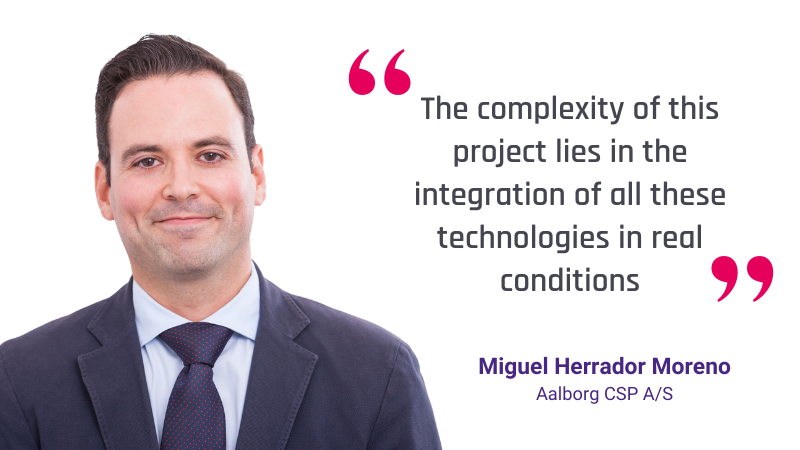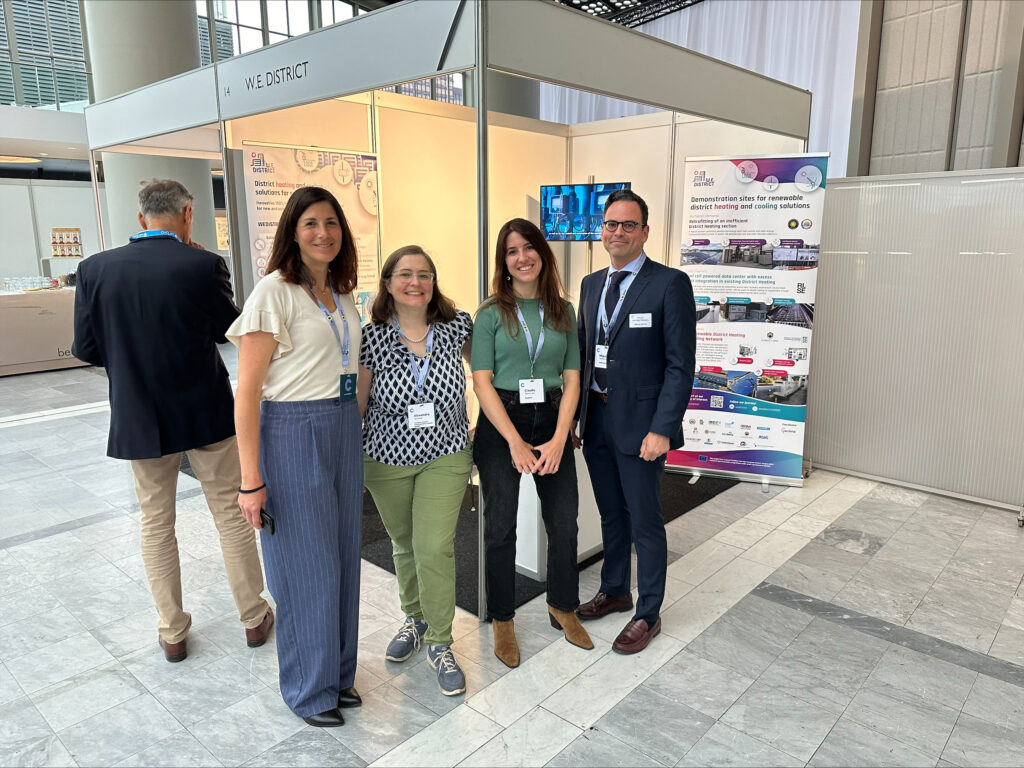
Miguel Herrador Moreno is a mechanical industrial engineer from the University of Seville. He has 20 years of experience specializing in solar thermal technology and energy storage systems. He works with Aalborg CSP, a Danish company that has a technical office and workshop in Seville, who are a W.E.District project partner. They explained us the project’s Cordoba demonstration site.
ESCI: Can you explain the technology at the Cordoba demonstration site?
Miguel: This is one of the W.E.District project technologies using parabolic trough technology which are solar collectors shaped like parabolas that focus sunlight onto an absorber tube. The highly reflective surface directs the sun’s rays to a carbon steel tube with coatings to reduce heat losses. While thermal oil is usually used for high-temperature power generation, we use water here since the required temperature is only 95°C, much lower than the 393°C needed for electricity production.
ESCI: What was the most innovative part of this installation?
Miguel: The W.E.District project integrates multiple technologies, including three different concentrating solar thermal systems: parabolic troughs, Fresnel collectors, and flat plate technology with a mirror concentrator from Spanish company SEENSO. On the generation side, these technologies meet the heating and cooling demands of the Da Vinci building and provide hot water for Monte Cronos. The system also includes a biomass boiler with two 500-kilowatt units. The project integrates local solar resources in Cordoba to meet the energy needs of the Rabanales University Campus.
ESCI: Can you explain what makes the parabolic trough so unique and novel?
Miguel: The photovoltaic plate in the center allows the collector to adjust its position to always face the sun, autonomously, ensuring optimal thermal energy production.
ESCI: What is inside the tubes?
Miguel: The absorber tubes in our solar thermal plants consist of an inner carbon steel tube with a selective paint coating to maximise radiation absorption. A clear glass envelope covers the tube to reduce the thermal losses. The water inside the tubes is heated to 95°C to meet energy demands for the Da Vinci building and absorption machine.
ESCI: When you think about the start of the installation, what comes to your mind? Did you face challenges and how did you approach them?
Miguel: The main challenge we face is integrating different renewable technologies, each with its own operation mode. The solar field, for example, is affected by solar transmits like a passing cloud, while the heating and cooling demand is also intermittent, being necessary an intermediate storage system. The goal is to meet the real energy needs of the Cordoba university campus. Another challenge is building a complex, small-scale industrial demonstration plant, overseen by UCO, which had to manage the engineering, procurement, construction, and upcoming commissioning phases.
ESCI: What is the main role of your work in the project?
Miguel: Aalborg CSP initially served as the Technical Scientific Coordinator of the project, focusing on integrating various renewable technologies. As the project progressed, Aalborg’s role expanded to include the mechanical integration of all technologies at the University of Cordoba demo plant. They created a 3D model of the plant to optimise equipment layout and integration, facilitating future maintenance and operation. This model was developed by their engineers in Denmark and Seville, drawing on their expertise in solar thermal plant assembly and commissioning.

ESCI: Is it possible to look in the future without any concerns or issue about the expected results of the system?
Miguel: At this site we will be able to see how these technologies work. This setup allows us to compare the performance of these technologies under the same conditions, with independent measurements of flow, temperature, and pressure for each system.
ESCI: What is the potential for this pilot plant to be used as an industry solution for District heating?
Miguel: Many times, in commercial plants, it’s often hard to test innovations like new absorber tubes, mirrors, or operation strategies due to limited downtime. However, in the university environment at the Cordoba plant, there’s easier access for testing these components. The facility provides an opportunity for the industry to trial new technologies before implementing them in commercial plants.
The installation has been put in place. They have been shown in a clear way so that students can perfectly distinguish the different circuits for both hot and cold water with the different technologies. The plant has been built with a visual clarity and ease of assembly in mind, ensuring simple operation and maintenance. This setup suits the university and research environment, unlike typical commercial plants.
ESCI: Can you describe the design a bit?
Miguel: The main solar thermal technologies are distributed with a closed system and with pumps and shut-off valves and temperature gauges. So, we can identify or extract the actual performance of each of the technologies. Working in parallel, all of it goes into a cold collector, a hot collector and a buffer tank.
ESCI: What is the most complicated part of the plant design?
Miguel: The most challenging part of the plant design was integrating all the technologies while minimising piping and ensuring easy operation and maintenance. The 3D model was carefully planned with input from UCO, Danish engineers, and on-site experts. The piping layout was optimised to reduce support structures and ensure easy access to valves. Additionally, the design considered manual cleaning of mirrors and collectors, as it is a small pilot plant and therefore doesn’t support mechanical cleaning systems. So, we considered all these factors.
ESCI: What was the idea of the 3D animation?
Miguel: The idea of the 3D animation, which was created by our Danish engineering team, is to show the plant’s design, integrating all technologies, valves, and mechanical equipment. It includes people for scale to visualise equipment size. The animation ensures that all operable elements, both automatic and manual, as well as safety systems like hydraulic safety valves and defocusing collectors, are easily accessible.
It was crucial to include UCO personnel, who will operate and maintain the plant, alongside our experienced Spanish team familiar with solar thermal maintenance and mechanical design. Coordinating these three teams from the start proved to be the most complex aspect.
ESCI: Is it necessary to have a biomass boiler?
Miguel: The idea of the biomass boiler is to act as a backup system to the solar field. If we add the power of the solar field, we have a total of 500 thermal kilowatts coming from CSP technologies. In this boiler we have 1 megawatt of thermal energy to act as a backup system for the solar field when the sun is not shining.
ESCI: Are you thinking about the results of the pilot plans?
Miguel: Well, the plant will surely give very positive results. Not only in terms of each of the technologies, but also in terms of integration.
ESCI: Thank you for this interview!